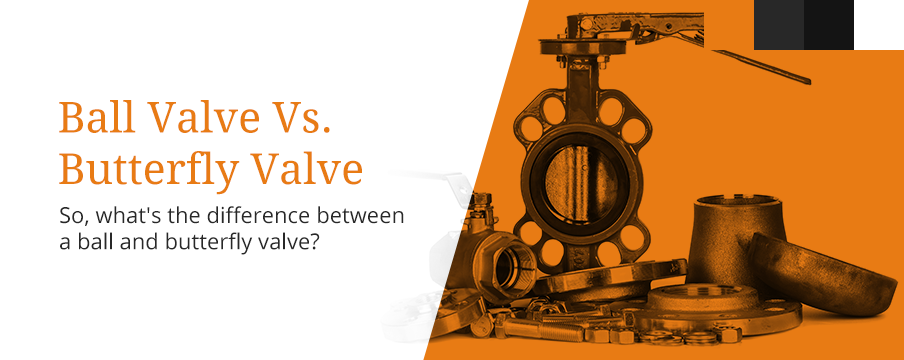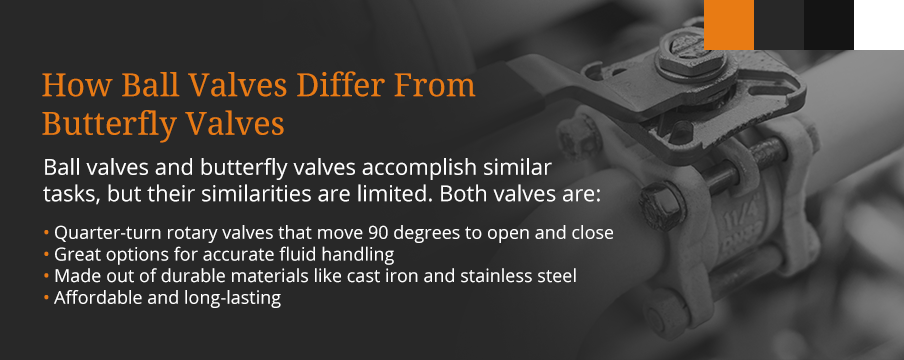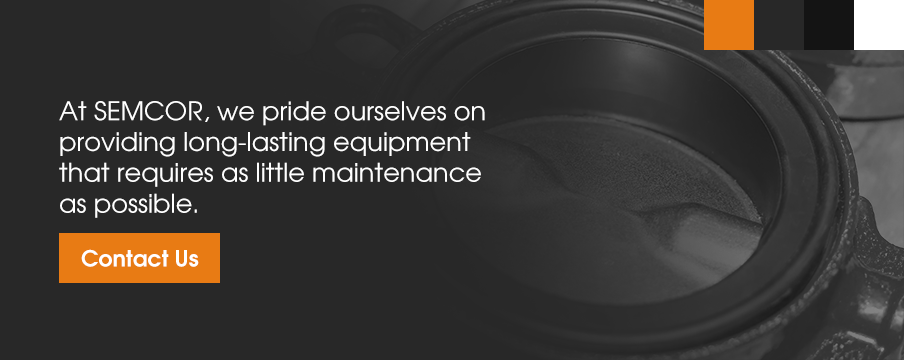
Engineers who need to control the flow of a gas or liquid often turn to ball valves and butterfly valves. Both are quarter-turn rotary valves that are inexpensive and durable. They are both excellent for regulating flow at a wide range of temperatures. So, what’s the difference between a ball and butterfly valve?
Though the differences are subtle, they each have unique characteristics that make them ideal for specific applications. Factors like pressure differences, quality of seal and supply pipe size can make either a butterfly or ball valve more beneficial for a project.
Ball Valves
A ball valve consists of a floating ball with a hole running through it. When the valve is activated, the hole is aligned in a way that blocks, partially blocks or completely opens the flow of liquid or gas. There are several benefits to using ball valves, including the tight seal, which is ideal for applications involving gas flow. They are often used in high-pressure liquid or gas lines that are less than 6 inches in diameter. Ball valves offer almost no resistance when turning them, even if the supply side is creating high pressure. Some designs provide no drops in pressure. Most ball valves can operate in temperatures between -30℃ to 230℃. There are several kinds of ball valves, including:
- Full-port ball valve: The hole in the ball is the same size as the pipeline, providing an uninterrupted flow. In this approach, no friction loss occurs due to different opening sizes.
- Reduced-port ball valve: The hole in the ball is slightly smaller than the pipe, which somewhat restricts flow. This design increases the velocity of the flow and makes the valve less expensive.
- V-port ball valve: In this design, the ball or seat is V-shaped. As the valve is activated, the small end of the V opens first, providing a more stable flow. Many choose to use these valves in applications where more control or high velocity is required. They tend to have a more sturdy construction that can hold up against high velocities that may ruin another valve.
- Cavity filler ball valve: For some applications, such as those in food production or healthcare, the residue that stays inside a ball valve can become a health hazard. Changing the fluid that goes through the pipe could lead to contamination issues, as well. A cavity filler plugs the hole by extending the seats, preventing these buildups from occurring.
- Trunnion ball valve: The ball is anchored to the top and bottom of the valve. This design is often required in large-scale or high-pressure applications to prevent the ball from floating off and causing problems with the seating mechanism.
Butterfly Valves
Butterfly valves are a lightweight valve that comes in one- and two-piece designs, named after their resemblance to the wings of a butterfly. In the two-piece design version of these valves, the sections fold inward to allow full flow and lie flat when closed. In a one-piece design, a disk is mounted on a shaft that rotates around the pipe. Activating the valve turns the disk to fully open or block the flow of gas or liquid through the valve. Butterfly valves are usually one of two types: lug and wafer valves. These two types mainly differ in their installation designs.
- Wafer valves: Wafer valves are fairly standard and often less expensive than lug valves. The valve is installed between two flanges with bolts or studs and nuts. With this design, you cannot disconnect one side of the piping, but if that is not required, wafer butterfly valves are an excellent option.
- Lug valves: For a less permanent fixture, lug butterfly valves use threaded metal inserts in the bolt holes of the valve, so no nuts are required. A separate set of bolts goes on either side of the flange. This design allows you to disconnect one side of the piping system and leave the other side untouched.
These valves are typically less expensive in terms of materials and maintenance. They are also lighter than ball valves and are faster to open and close. They are often used in large-scale projects, such as municipal water systems and sewers. Applications that require the control of flow from a body of water often use butterfly valves. If flow loss is not an issue, then butterfly valves are excellent for controlling flow and pressure. Another benefit of butterfly valves is that they are smaller than ball valves, which is useful for projects that need to minimize space.
How Ball Valves Differ From Butterfly Valves

Ball valves and butterfly valves accomplish similar tasks, but their similarities are limited. Both valves are:
- Quarter-turn rotary valves that move 90 degrees to open and close
- Great options for accurate fluid handling
- Made out of durable materials like cast iron and stainless steel
- Affordable and long-lasting
The primary difference between the valves lies in their effect on flow. In butterfly valves, part of the disk interferes with the flow, creating a drop in pressure. For applications where consistent or high pressure is needed, this, of course, is a disadvantage. The pressure change can also make the valve difficult to operate due to the incoming pressure from the supply side. A bypass valve could be needed to balance out the pressure before a butterfly valve can work appropriately. Alternatively, the ball valve offers 100 percent flow with its design. It can be used for projects where higher pressure is needed.
Another consideration is the size of the application. Due to their design, ball valves typically become less cost-effective at around 6 inches in diameter. At that point, butterfly valves generally are the more economical choice. They are lighter and tend to be more affordable. These characteristics make them great for large-scale projects where flow control is less of a concern. Plus, butterfly valves don’t trap fluids like a ball valve can, so a butterfly valve may be better for applications in food production, where residues can create health hazards.
Find a Valve Supplier
The uses for both ball and butterfly valves are extensive, and they are each widely used across industries. They are simple to install and typically made of durable materials. Both ball and butterfly valves are available at low costs. At SEMCOR, we pride ourselves on providing long-lasting equipment that requires as little maintenance as possible. We offer valves from AMRI, Apollo, Richter, ITT and more.
We’ve been in business for more than a century, and over the years, we’ve learned what makes a good product. Dependability, durability and affordability are among our top considerations. If we don’t have a valve that meets your needs, we can even create a custom-made valve for your project. Reach out today for more information on our process and product options.





